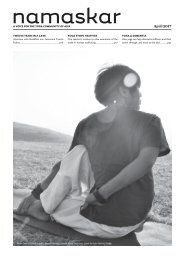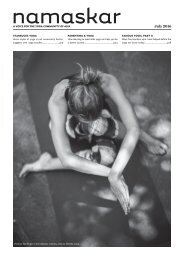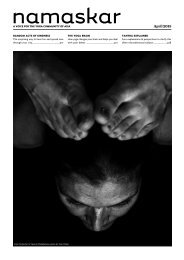Create successful ePaper yourself
Turn your PDF publications into a flip-book with our unique Google optimized e-Paper software.
Postponing Death<br />
Dr. Mihaiela Pentiuc<br />
It may seem as if we can write easily about our passions, hopes,<br />
dreams, expectations, life. But when it comes to death, words<br />
escape us and inspiration seems beyond reach. It does not matter<br />
how certain death is, we keep on postponing its reality in our<br />
minds. It does not matter how often we have met death – through<br />
loved ones who have left, or even events in the news – we keep<br />
thinking: It’s not about me. In order to live happily we build an<br />
entire coping system that takes the mind away from the frightening<br />
certitude of our own deadline.<br />
Medical books describe a very rare disease that causes people to<br />
think they are dead or that parts of their body are missing or<br />
rotten. It is called Walking Corpse Syndrome (Cotard’s Syndrome)<br />
and its source can be partially found in a disconnection between the<br />
areas in the brain that process information from the sense organs<br />
and the site of their emotional processing. It is like seeing, feeling,<br />
tasting the body, but being unable to appreciate this is me, mine, or<br />
normal. What does the mind do when confronted with this odd<br />
separation? Usually it makes up a story, an explanation that will<br />
solve the dilemma, but most commonly does not match reality.<br />
Generally speaking, when our sense of identity is not associated<br />
with our sensory perceptions, we feel as if we are dead.<br />
to live happily we build a coping<br />
system to take the mind away from<br />
our own deadline<br />
In Yoga, pratyahara, the fifth of the eight stages of Patanjali’s<br />
traditional system, advises the sadhaka to train in the “withdrawal<br />
of the senses,” the voluntary separation of the internal activity of<br />
the mind from external disturbances. In this practice smell, taste,<br />
sight, touch, and hearing are not processed anymore in their<br />
respective centers in the brain; the sense organs are totally<br />
functional while the brain does not acknowledge their activity.<br />
Pratyahara is the essential turning point that takes the practitioner<br />
to the superior levels of yoga – dharana (concentration), dhyana<br />
(meditation), and samadhi.<br />
Stretching the analogy a little, we can say before reaching samadhi the<br />
yogi must change the habitudes of his brain activity, which is in a<br />
way like undergoing death. It is very common before entering<br />
samadhi to experience a certain amount of fear – either a fear of<br />
death or fear of insanity. Many practitioners stop at this point,<br />
while others spend a lot of time roaming to the edge of this range,<br />
which reveals the extinction of the ego. Unfortunately there is no<br />
other way to gain passage to greater depths but by passing through<br />
this gateway, a necessary step that changes the psychological focus<br />
but also imprints on our biology. The brain has to be trained; our<br />
body has to face what will normally be translated as death and<br />
destruction in order to accommodate the higher stages of sadhana.<br />
How does the yogi know he or she is not going mad, is not<br />
damaging the brain, and won’t become a zombie like the severe<br />
sufferers of Cotard’s Syndrome?<br />
It is a common procedure in neuroscience to observe pathological<br />
conditions in order to understand the function of the normal<br />
brain. For a yogi it is even more fascinating to recognize the effects<br />
of yoga practice in what science describes.<br />
Yoga and meditation change both our body and brain. Pathology<br />
and disease are also based on sometimes similar changes of the<br />
brain. Why does one lead to bliss while the other to misery? Are<br />
there signs that tell us clearly in which direction we are heading?<br />
If I want to taste the exquisiteness of infinity I have to accept the<br />
need to courageously look into the face of death. On the verge of<br />
extinction’s abyss, is there something that can reassure me of an<br />
afterlife of samadhi? Unfortunately the answer is no. Facing death<br />
means facing no compromises, no half-doses, and no selfcomforting.<br />
From outside, the guru or teacher can appreciate the<br />
signs but inside it is just that: a solitary confrontation with the dark<br />
night. The only real, reliable, guiding light is gradual consistent<br />
practice: pratyahara – withdrawal from the ongoing processing of<br />
external sensory stimulation – and one-pointed concentration of<br />
the mind leading to deep levels of meditation.<br />
This is no easy step and dreaming about bliss without the courage<br />
to confront death is like suffering from thirst while being averse to<br />
drinking. Speaking about abhinivesha – the fear of death, or the<br />
excessive attachment to life – Patanjali himself acknowledged this<br />
describing it as being “deeply rooted even in the sages.”<br />
All those who hold the ambition to reach the highest yogic<br />
achievements are bound to bear witness to the very deep<br />
transformation brought about by one’s confrontation with death.<br />
It starts with the effort of the mind to redirect its attention and<br />
concludes with physiological changes of the brain. Meanwhile a<br />
wide range of emotional and philosophical challenges can surge up.<br />
We do need to apply new processing terms, to learn new<br />
translation skills or new emotional values. Seeing must be replaced<br />
by inner vision, external consistency exchanged for the certainty of<br />
internal perceptions, permanent sensorial bombardment easily<br />
turned into awakened calmness.<br />
This is how the advanced stages of yoga become the realm of<br />
heroes, men and women with determination and real longing for<br />
truth and freedom. From this perspective we can understand why<br />
Shiva, the archetypal image of the yoga guru, also received the name<br />
Bhairava, the terrible one.<br />
Some who initially feel an enthusiastic attraction to yoga may feel<br />
discouraged at this point. Isn’t there an escape, a shortcut, a<br />
“happy-go-lucky” path to samadhi? We want the bliss but not the<br />
confrontation. Let’s look around: Is there a place where death can<br />
be avoided? Is it possible by facing it courageously we can stop<br />
fearing it and understand death as transformation? Yogic wisdom<br />
provides answers and practical solutions, showing again how this<br />
ancient system is reliable for much more than healthy stretching or<br />
relaxation.<br />
Mihaiela is a senior yoga teacher at Agama<br />
Yoga, Thailand. mihaiela@agamayoga.com<br />
Agama Yoga offers its ‘Art of Dying’ workshop<br />
25-29 March 2013 www.agamayoga.com<br />
15

















